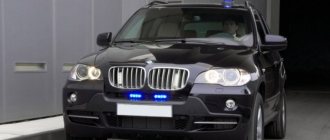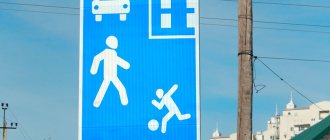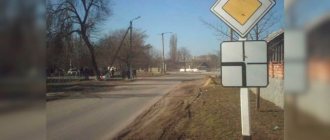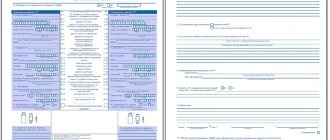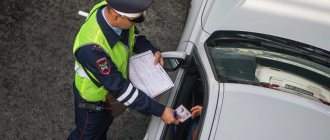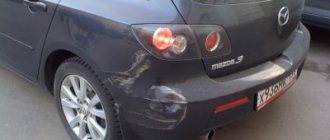The Supreme Court clarified who drivers should not yield to when leaving the yard
Some situations occurring on the road are often very difficult to understand even for experienced traffic police officers. But in practice, there are cases when you begin to doubt the professional suitability of some representatives of the law and order. A striking example of a very strange decision regarding one road accident is the Supreme Court ruling dated December 14, 2021, number 44-AD18-21.
When leaving the yard, keep your eyes open!
In the city of Perm last winter, a seemingly ordinary traffic accident occurred. Two cars collided. One of them was leaving the courtyard area, the other was driving along the main road:
“In violation of paragraph 8.3 of the Traffic Rules,” the materials of the administrative case say, “when leaving the adjacent territory, she did not give way to a Volkswagen Passat vehicle.”
As you can see, everything is very prosaic and standard. Any driver, even someone who has recently received a driver’s license, can easily say who is to blame for this accident; it is enough to be guided by one point of the traffic rules:
"8.3. When entering the road from the adjacent territory, the driver must give way to vehicles and pedestrians moving along it, and when leaving the road - to pedestrians and cyclists whose movement path he crosses.”
In other words, we give way to everyone, not just vehicles.
However, in our case, which was included in the practice of the Supreme Court, there was one significant nuance: the Volkswagen Passat was moving on a one-way road in the opposite direction .
These circumstances served as the basis for attracting... N.V. to administrative liability provided for in Part 3 of Article 12.14 of the Code of the Russian Federation on Administrative Offences.
And who is now to blame for this situation? To solve this problem, you need to introduce additional input. The street to which the exit from the yard was made was one-way. At the exit from the houses there was a sign 2.4 “Give way” and a sign notifying that the street on which the maneuver was being made was one-way.
The driver, or rather the driver, looked in the direction of the movement of vehicles and missed all the obstacles, and began to move. She could not imagine that an intruder would fly out at her from the other side.
See also: Yield to the obstacle on the right: the rule does not always work
Logic dictates that the one who was driving in the oncoming lane was to blame for the incident (the traffic police officers handed him a report on violation of the Traffic Rules under Part 3 of Article 12.16 of the Code of Administrative Offences), but a report was also issued against the woman under Part 3 of Article 12.14 of the Code of Administrative Offenses ( Failure to comply with the requirements to give way) and a fine of 500 rubles was issued.
That is, according to traffic police officers, the driver really should have foreseen such a situation and given way if necessary. Is this position correct?
According to the judge of the Sverdlovsk District Court of Perm, then the judge of the Perm Regional Court and the deputy chairman of the Perm Regional Court, the State Traffic Inspectorate employees did everything right and the woman violated the traffic rules. However, the administrative violation case reached the Supreme Court, which ruled otherwise.
GENERAL PROVISIONS
1.1.
In order to increase the level of improvement of local areas in the city of Moscow, as well as to ensure a comfortable urban living environment, the closure of the through passage by installing two barriers equipped with an access and video surveillance system at the address: Moscow, Altufevskoye Shosse, 86, was carried out in accordance with the resolution of the Moscow Government dated July 2, 2013 No. 428-PP “On the procedure for installing fencing in local areas in the city of Moscow”, Resolution of the Council of Deputies of the Bibirevo municipal district No. 4/9 dated April 24, 2018 “On approval of the installation of fencing devices in the local area of an apartment building at the address: Altufevskoye highway, house 86. 1.2. The adjacent territory is intended for joint use by the following persons (hereinafter in the text of these Rules collectively referred to as “tenants”): 1.2.1. owners of residential and non-residential premises of an apartment building; 1.2.2. persons living in the house on the basis of social tenancy agreements; 1.2.3. persons living with the owners on the basis of permanent registration; 1.2.4. persons renting residential premises in a house on the basis of rental agreements for residential premises; 1.2.5. persons renting non-residential premises on the basis of lease agreements. This list is closed.
1.3. The local area may be used by the persons listed in clause 1.2 of these Rules for the following purposes: 1.3.1. unhindered entry and exit by personal transport, namely: cars, motorcycles, mopeds, scooters and other vehicles with a permissible maximum weight of less than 3.5 tons; 1.3.2. temporary storage of personal vehicles.
1.4. Within the framework of these Rules, personal transport includes the following categories: 1.4.1. vehicles owned by residents as private property (confirmed by a Vehicle Registration Certificate); 1.4.2. vehicles used by residents on the basis of long-term leasing or rental agreements between a legal entity and an individual. Long-term leasing or rental agreements within the framework of these Rules are agreements concluded for a period of 6 months or more (confirmed by the Vehicle Registration Certificate and the leasing or rental agreement); 1.4.3. vehicles registered in the name of individuals who are related to the residents, but actually used by the residents (confirmed by a Vehicle Registration Certificate, OSAGO policy, power of attorney to drive a car (if any); 1.4.4. vehicles owned by right of ownership or on the basis of long-term leasing or rental agreements for legal entities or individual entrepreneurs who are owners or tenants of premises in an apartment building (confirmed by the Vehicle Registration Certificate and relevant agreements).
1.5. Vehicles owned by legal entities are not considered personal transport, except in cases where the legal entity is the owner or lessee of premises in an apartment building or if it leases vehicles for a long term or lease to residents of the building. Also not considered personal transport are vehicles intended for commercial use, namely: taxis with yellow license plates licensed to carry passengers, minibuses and trucks.
1.6. When operating fencing devices, round-the-clock and unhindered access to the local area is provided for fire equipment, law enforcement vehicles, emergency medical services, services of the Ministry of the Russian Federation for Civil Defense, Emergencies and Elimination of Consequences of Natural Actions, gas organizations and utility services through the dispatch service .
1.7. Fencing devices are community property and their maintenance, improvement and repairs are carried out at the expense of residents. In some cases, financing for the maintenance, improvement and repair of fencing devices may be carried out at the expense of third parties, namely, those causing damage or persons wishing, on their own initiative, to contribute to the improvement and preservation of common property.
Supreme Court decision
«Establishing guilt involves proving a person’s guilt in committing an unlawful action (inaction), that is, the objective side of the act.
According to clause 8.3 of the Traffic Rules, the violation of which was charged to N.V. Borisova, when entering the road from the adjacent territory, the driver must give way to vehicles and pedestrians moving along it, and when leaving the road - to pedestrians and cyclists whose movement path he crosses.
See also: Can drivers be fined for the same traffic violation several times a day?
By virtue of paragraph 1.2 of the Traffic Rules, the requirement to give way (not create interference) means that a road user should not start, resume or continue moving, or carry out any maneuver if this may force other road users who have an advantage over him , change direction or speed.
Advantage (priority) is the right to priority movement in the intended direction in relation to other road users (Road Rules) ,” the resolution says.
Did the driver of the car, violating the Traffic Rules (proven by the protocol and diagram of the accident) and moving in the opposite direction on a one-way road, have an advantage over anyone? No! This means that other drivers had no obligation to give way to him on the basis of traffic regulations. And therefore, both the traffic police resolution and the subsequent court decisions are subject to cancellation. The imposition of a fine is also unfounded.
PROCEDURE FOR IMPLEMENTING THE RIGHT TO USE THE HOUSE TERRITORY.
2.1. Passage through the barriers is possible in the following ways: 2.1.1. Opening by calling from mobile or landline phones registered in the register; 2.1.2. Opening via smartphone application; 2.1.3. Opening by dialing a one-time PIN code on the barrier panel; 2.1.4. Opening using a button to call the dispatcher (only for emergency and public service vehicles listed in clause 1.5. of these Rules); 2.1.5. Opening by the person responsible for operating the barrier, upon prior written application; 2.1.6. Opening using a license plate recognition system (if technically possible); 2.1.7. Opening upon departure is carried out automatically using an induction loop or by methods similar to those for entry.
2.2. To be able to open the barriers, it is necessary to enter a mobile or landline telephone number, as well as the vehicle number in the register maintained by the person responsible for the operation of the barriers, except for the transport of emergency and public services listed in paragraph 1.5 of these Rules. To be included in the register, you must personally appear with documents confirming the right to use the adjacent territory to the SMD room located in the 5th entrance.
2.3. The reception hours of the person responsible for collecting funds are set on Mondays, from 19.00 to 21.00 from September to October inclusive. Before coming, you must obtain confirmation of admission from the person responsible for collecting funds. By agreement with the person responsible for collecting funds, a different time for reception may be agreed upon for the purpose of entering data into the register.
2.4. To be included in the register, it is necessary to provide the person responsible for collecting funds with the following documents: 2.4.1. passport of a citizen of the Russian Federation confirming registration in the house; 2.4.2. certificate of ownership or extract from the Unified State Register of Real Estate (if the owner is not registered at the place of residence); 2.4.3. Vehicle registration certificate; 2.4.4. Vehicle leasing or rental agreement (if applicable); 2.4.5. MTPL policy (to confirm the right to use a vehicle that is not owned by the resident); 2.4.6. Residential rental agreement (for tenants); 2.4.6. Lease agreement for non-residential premises (for tenants of non-residential premises); 2.4.7. In cases not provided for by these rules, additional documents may be required to confirm a person’s right to use the local area.
2.5. A new owner of residential/non-residential premises or an owner who has not previously participated in the financing of the organization, equipment and maintenance of fencing devices may submit an application to an authorized person to enter his telephone numbers and vehicle into the general register of telephone numbers, which ensures the automated opening of barriers. After paying a one-time contribution to finance the organization, equipping fencing devices, as well as the formation of a reserve fund, information about the new resident, his vehicle and telephone number is entered into the register within a period not exceeding 24 (twenty-four) hours from the date of payment of the fee.
2.6. Participation in the financing of the organization and equipment of fencing devices, together with the payment of monthly fees for maintenance and 24-hour dispatch service, gives vehicle owners the right to: 2.6.1. entry/exit and stay in the local area at any time of the day by any means listed in clause 2.1. (except for opening through a dispatcher call from the calling panel, intended only for emergency and public services), but does not guarantee the availability of a parking space due to their limited number; 2.6.2. to include up to 2 (two) mobile or landline phone numbers per room in the register of telephone numbers, ensuring automated opening of barriers; 2.6.3. to include up to 2 (two) vehicle license plates per premises.
2.7. In cases where more than 2 car owners live in one apartment, 1 (one) telephone number and 1 (one) vehicle number are entered into the register for each owner. The total number of vehicles registered per apartment cannot exceed the total number of owners of such apartment.
2.8. The resident must notify the person responsible for operating the barriers in advance (before the start of passage through the barrier) about a change of vehicle or its registration number and ensure that the changes are made to the register.
2.9. Residents who are not owners of vehicles, and who did NOT take part in financing the organization and equipping of fencing devices, OR who did NOT pay for maintenance and services of a 24-hour dispatch service on time/in full, have the right: 2.9.1. round-the-clock entry/exit of vehicles by dialing a PIN code on the barrier calling panel for the purpose of boarding/disembarking passengers with limited mobility or loading/unloading, but no more than 2 (two) hours continuously; 2.9.2. for inclusion per resident of: 1 (one) city or mobile number in the register of telephone numbers, providing automated opening of barriers using a PIN code.
2.10. Due to the limited number of spaces in the local area intended for temporary parking of personal vehicles, the right to park applies to the personal vehicles of residents, taking into account the following principles: 2.10.1. parking spaces are not assigned to a specific resident or vehicle; 2.10.2. Entry to the local area in the absence of free parking spaces is possible for boarding/disembarking passengers and other purposes for a time not exceeding 15 minutes.
2.11. Access to the local area for taxis, delivery services and vehicles of other services and organizations is carried out using a one-time PIN code. The presence of data of vehicles not registered in the register in the local area is strictly LIMITED for the time for disembarking/embarking passengers with limited mobility, loading/unloading cargo, luggage, etc., BUT no more than 2 (two) hours continuously. For persons who took part in the financing of fencing devices, it is permissible to allow the above-mentioned vehicles to enter the local area using a smartphone application.
2.12. Before passing through the barrier, you must wait until it is completely open.
2.13. After driving through the barrier, you must immediately stop the car behind the barrier and wait until it closes, in order to avoid unauthorized vehicles entering the territory and causing emergency situations.
We draw a conclusion
Thus, for those drivers who did not violate the Traffic Rules at the time of the accident, this court decision can be extremely useful, because incidents often occur in the law enforcement area. Some people are “lucky” to run into an undeserved small fine, but for others, someone else’s impudence can cost them their rights or even their freedom.
Remember : a violator of traffic rules cannot take advantage of other road users. Proven by the Supreme Court more than once!
